Shiraz is known as the city of poetry and orange blossoms. Apart from being one of Iran’s best known cities for its enchanting gardens, it’s home to Persepolis, the world’s largest and most renowned historical monument. With its unique blend of urban and historical features, Shiraz attractions stands as one of Iran’s most cherished tourist destinations, captivating both domestic and international visitors. In May, this city transforms into an earthly paradise, adorned with the vibrant colors and heavenly perfume of spring orange blossoms.
In this two-part blog series in Parsi Tours Iran Travel Agency, we will be your guide as we explore the myriad of attractions that make Shiraz a must-visit destination. In Part 1, we’ll delve into the historical wonders, architectural marvels, and the vibrant cultural scene that defines this city. Join us on this virtual journey to discover the first half of what makes Shiraz so remarkable.
Hafezieh – Tomb of Hafez
Hafeziya, as one of Shiraz attractions, also known as the Tomb of Hafez, is situated in the northern part of Shiraz, near the Quran Gate, within the Khake Mosalla cemetery. It serves as a revered meeting place for admirers of Hafez’s poetry. Covering an area of approximately two hectares, this site features courtyards separated by a central hall. The history of Hafezieh Hall dates back to the Zandiye period, boasting dimensions of 56 meters in length and 8 meters in width, supported by 20 stone columns, each standing at five meters in height. The architectural style reflects influences from the Achaemenian and Zandian eras. Besides Hafez’s tomb, the surroundings of this place are graced with lush gardens and tall trees, enhancing its charm. Over the years, this building has undergone several renovations and improvements.
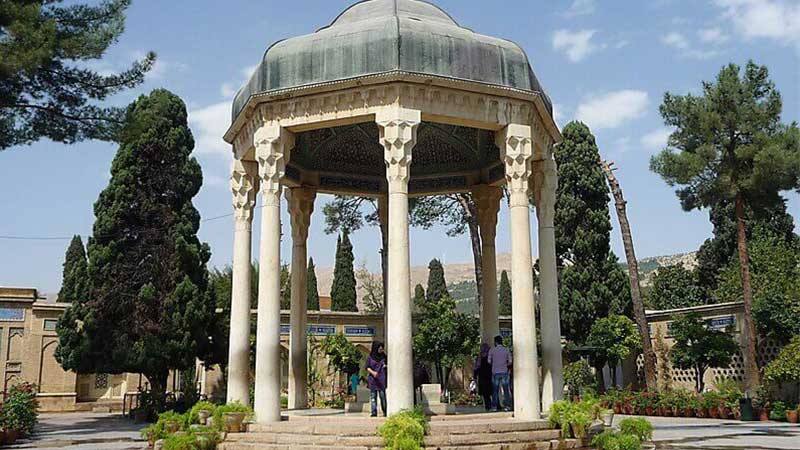
Tomb of Hafez
Saadi’s Tomb
Saadi’s Tomb stands as another historical gem in the city of poetry. Located at the end of Boostan Street, near Delgosha Garden, it’s the final resting place of the renowned poet Saadi. The tomb complex is also the burial site for other respected figures according to their wishes. This tomb was officially registered as a national monument in Iran. Originally, it was Saadi’s sanctuary, where he spent the latter part of his life. Karim Khan Zand commissioned the construction of a building on this site. Over time, it has undergone numerous renovations, culminating in the current structure completed in 1330, with a total area of 258 square meters.
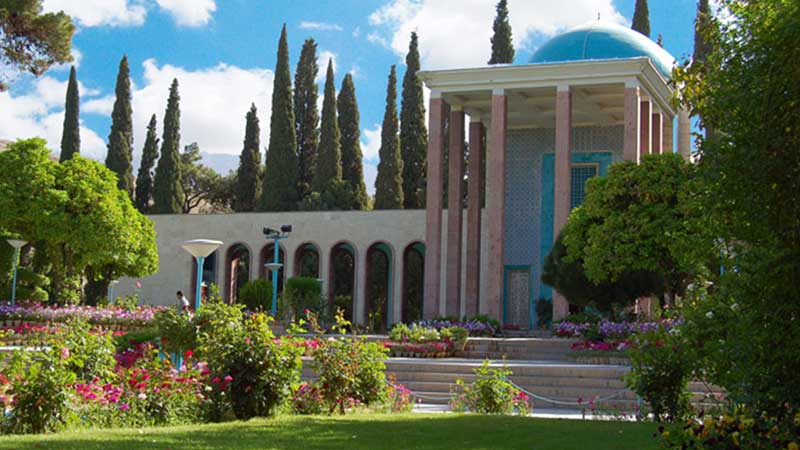
Saadi’s Tomb
Shahcheragh Shrine
Shiraz houses the shrine of “Mir Seyyed Ahmad,” known as Shahcheragh, the son of Imam Musa Kazem and brother of Imam Reza. The tomb was constructed in the 6th century AH during the Atabakan era of Fars, later rebuilt after an earthquake. The people of Shiraz hold a deep devotion for this shrine, often visiting to seek blessings and fulfill their needs. The dome and courtyard of Shahcheragh are decorated with exquisite tiles, mirrors, and beautiful Arabic and Persian calligraphy. Two entrances, located to the south and north of the tomb, provide access to the spacious courtyard, featuring a peaceful pond and surrounded by lush trees. Additionally, side doors open to Haji Bazaar and Jame Atiq Mosque. Shahcheragh Tomb is conveniently located near Ahmadi Square in Shiraz.
Quran Gate (Darvazeh Quran)
The Quran Gate of Shiraz is another historical attraction, located in the northeastern part of the city between the Chehel Maqam and Babakohi mountains. It serves as the city’s exit toward Marvdasht and features a Quran inscription. Karim Khan Zand initiated its reconstruction and placed two volumes of the Quran in a room on top of it, which are known as “17 Man Quran.” Today, these Qurans are preserved in the Pars Museum. During the first Pahlavi era, the old Quran Gate was dismantled on the orders of Reza Shah, and in 1328, a new gate was constructed slightly away from the original site, boasting larger dimensions.

Quran Gate
Khajavi Kermani Tomb
Among the illustrious poets buried in Shiraz, Khajavi Kermani holds a special place. His tomb is located in the northern part of Shiraz, near the beginning of the Shiraz-Isfahan Road, and at the foot of Sabavi Mountain. The mausoleum offers stunning views of the Quran Gate and is bordered by the Roknabad spring, enhancing its beauty. The tomb of Khajavi Kermani was erected in 1315 with the support of the Culture Department of Fars Province. It features an open structure with no roof, and the tombstone is prominently displayed. In 1337, a room was added to the northern part of the tomb, now serving as the cultural center of Khajavi Kermani. This historic site is proudly listed as a national monument of Iran with number 916.
Qavam Narenjestan Garden
Qavam Narenjestan Garden, also commonly known as Qavam Garden, as one of Shiraz attractions, was built during the reign of Naser al-Din Shah, commissioned by Ali Muhammad Khan (Qavam al-Mulk II). Covering an area of 3,500 square meters, the garden features a building with a footprint of about 940 square meters. It includes a gate leading to a vestibule and courtyards accessed through parallel corridors. While the south side was reserved for staff, the north side served as the living quarters and venue for administrative ceremonies and guest receptions. The building is featured with exquisite decorative elements, such as mirror work, glasswork, carving, inlay work, stone carving, plasterwork, and moqarans work. In 1335, Narenjestan Garden was donated to Shiraz University and now functions as a museum. You can find Narenjestan Qavam Garden in the Balakoft neighborhood, at the eastern end of Lotfali Khan Zand Street.
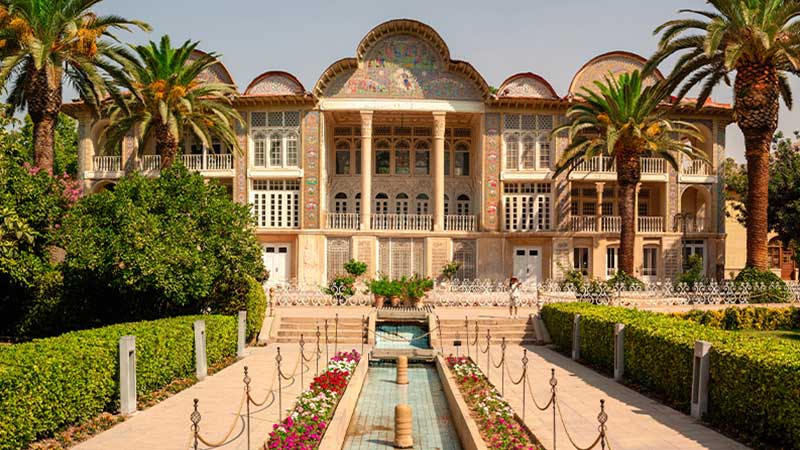
Qavam Narenjestan Garden
Eram Garden
Eram Garden in Shiraz ranks among the oldest and most beautiful gardens in the city and one of popular Shiraz attractions. It draws tourists each year with its historical charm and lush greenery. Although the exact origins of the garden remain uncertain, it is mentioned in travelogues and books from the 10th and 11th centuries of the Hijri calendar. Historical documents suggest its existence during the Seljuk and Al-Inju periods, with significant renovations carried out during Karim Khan Zand’s rule. The Qashqai tribe owned Eram Garden for 75 years during the Qajar era, adding a mansion to the premises. Subsequently, another mansion was constructed during the Qajar era, which still stands today. Currently, Shiraz University owns Eram Garden, which serves as a botanical showcase with a diverse range of plants and trees from around the world. In July 2013, Eram Garden, along with eight other Iranian gardens, was designated a UNESCO World Heritage Site.
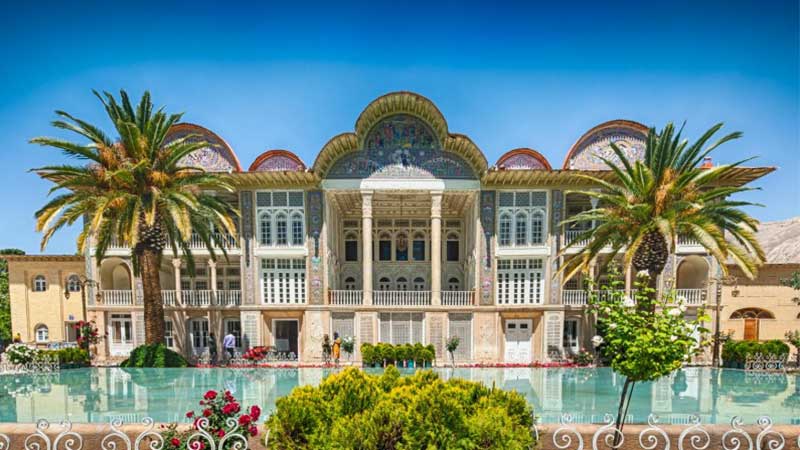
Eram Garden
Delgosha Garden
Delgoshai Garden, located near Saadi’s Tomb, is another historic garden in Shiraz. It is believed to date back to the Sassanid era, with mansions added during the Qajar period. Delgosha Garden is especially renowned for its fragrant orange blossoms in the spring, filling the air with a delightful aroma. The garden spans 7.5 hectares, positioned in the northeast of Shiraz, near Tangab Khan and at the base of the mountain. Within the garden, you can find a three-story mansion featuring a grand hall and four pavilions. It is said that Iran’s first Kolah Farangi was registered in this garden. Delgosha Garden was officially listed as a national monument of Iran on the 7th of Mehr in 2001, designated as number 912.
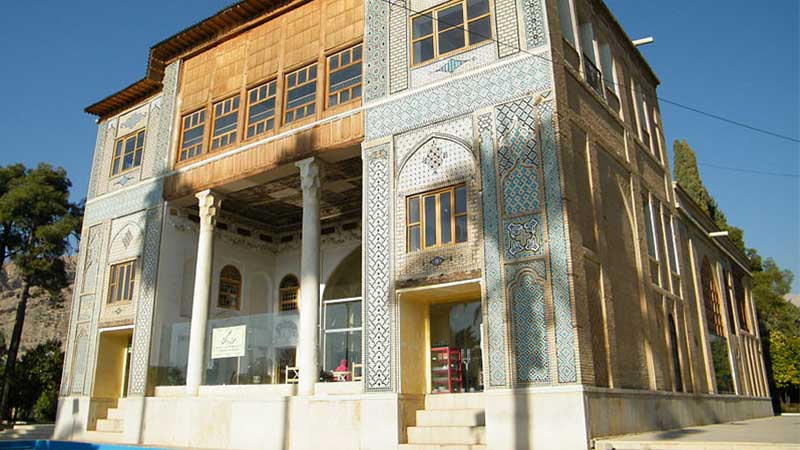
Delgosha Garden
Jahan Nama Garden
Jahan Nama Garden, situated on the eastern side of Hafez Street (Quran Gate) and above Hafezieh Square, stands as another historical and picturesque garden in Shiraz. Historical records suggest the garden’s existence during the reign of Al Muzaffar and Al Injo, and Hafez’s poems even mention its lush greenery. The garden thrived until the Safavid era but began to deteriorate during times of unrest in the country. Under the Zandian rule, Karim Khan Zand restored the garden and constructed a central mansion. During the Qajar dynasty, Jahan Nama Garden remained a place of splendor and entertainment for government guests. The garden features cypress and pine trees, citrus trees, and various other fruit-bearing trees, creating a peaceful and verdant atmosphere. Within the garden stands an octagonal two-story mansion with four pavilions and numerous rooms. The facade is made of brick, and the original wooden windows have been replaced with iron. Presently, Jahan Nama Garden is under the ownership of Shiraz Radio and Television.
Afif Abad Garden (Golshan Garden)
Afif Abad Garden, also known as Golshan Garden, is located in the western part of Shiraz, south of Qasr al-Dasht Street and above Rahmat Abad Garden. Mirza Ali Mohammad Khan Qavamul-Mulk II initiated the construction of the mansion inside the garden in 1284 AH. In 1863, a complex was built, including a royal palace, a museum of old weapons, and an Iranian garden, all of which can be visited by enthusiasts today. The garden shows exquisite Iranian floral motifs and spans an area of about 127,000 square meters, with a building base of 17,000 square meters. The garden is currently under the control of the army and houses one of the largest weapons museums in the Middle East and one of Shiraz attractions. It was officially registered as a national monument of Iran in 1351, designated as number 913.
Arg-e Karim Khan
Arg-e Karim khan or Karim Khan Citadel is a historic relic and one of Shiraz attractions from the Zandieh era, located in the heart of Shiraz. After designating Shiraz as his capital, Karim Khan Zand chose this citadel as his residence, leading to its association with his name. The citadel was meticulously constructed in 1766 and 1767, employing the finest architects and materials.

Arg-e Karim Khan (Karim Khan Citadel)
During the Qajar era, the citadel served as the residence of local governors but was later during the Pahlavi era repurposed as a prison, suffering considerable damage in the process. In 1350, the Karim Khan Citadel was entrusted to the Department of Culture and Art and turned into one of Shiraz attractions, and it is currently undergoing renovation to transform it into a comprehensive museum showcasing the rich history of Fars province.



